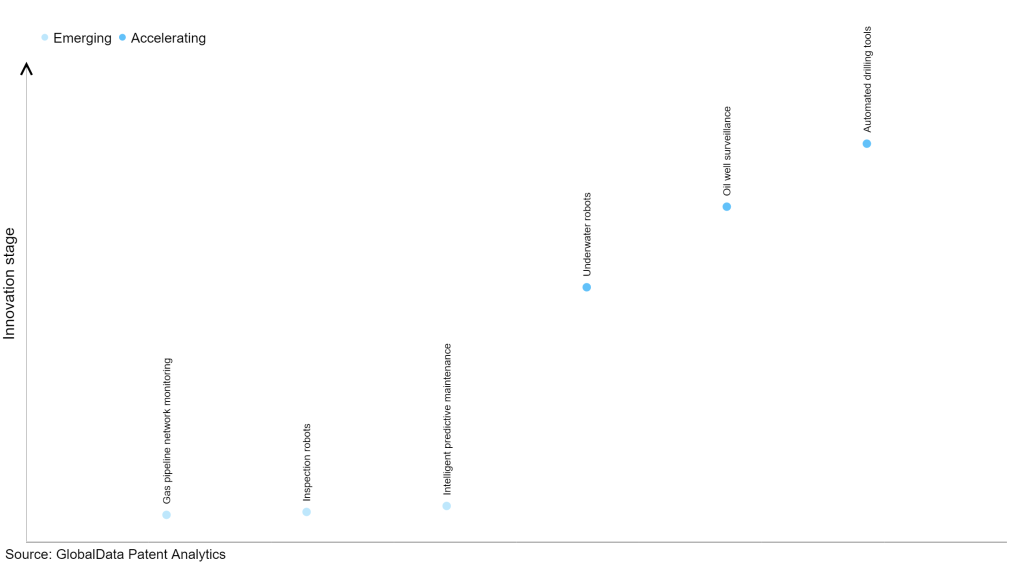The oil & gas industry continues to be a hotbed of patent innovation. Activity is driven by the need to improve operational efficiency, reduce costs, and enhance safety, and growing importance of technologies such as artificial intelligence (AI), cloud computing, automation, and big data. In the last three years alone, there have been over 327,000 patents filed and granted in the oil & gas industry, according to GlobalData’s report on Internet of Things in oil & gas: underwater robots. Buy the report here.
However, not all innovations are equal and nor do they follow a constant upward trend. Instead, their evolution takes the form of an S-shaped curve that reflects their typical lifecycle from early emergence to accelerating adoption, before finally stabilizing and reaching maturity.
Identifying where a particular innovation is on this journey, especially those that are in the emerging and accelerating stages, is essential for understanding their current level of adoption and the likely future trajectory and impact they will have.
65+ innovations will shape the oil & gas industry
According to GlobalData’s Technology Foresights, which plots the S-curve for the oil & gas industry using innovation intensity models built on over 201,000 patents, there are 65+ innovation areas that will shape the future of the industry.
Within the emerging innovation stage, gas pipeline network monitoring, inspection robots and intelligent predictive maintenance are disruptive technologies that are in the early stages of application and should be tracked closely. Underwater robots, oil well surveillance and automated drilling tools are some of the accelerating innovation areas, where adoption has been steadily increasing.
Innovation S-curve for Internet of Things in the oil & gas industry

Underwater robots is a key innovation area in Internet of Things
Underwater robots, also known as unmanned underwater vehicles (UUVs), are robotic devices designed to operate underwater without the need for human intervention. These robots are equipped with sensors, propellers, and mechanical systems that enable them to navigate underwater environments and perform tasks such as inspection, surveying, data collection, maintenance, and exploration. Underwater robots can be either remotely controlled or operate autonomously, making them valuable tools for a wide range of applications in the marine industry, scientific research, and environmental monitoring.
GlobalData’s analysis also uncovers the companies at the forefront of each innovation area and assesses the potential reach and impact of their patenting activity across different applications and geographies. According to GlobalData, there are 45+ companies, spanning technology vendors, established oil & gas companies, and up-and-coming start-ups engaged in the development and application of underwater robots.
Key players in underwater robots – a disruptive innovation in the oil & gas industry
‘Application diversity’ measures the number of applications identified for each patent. It broadly splits companies into either ‘niche’ or ‘diversified’ innovators.
‘Geographic reach’ refers to the number of countries each patent is registered in. It reflects the breadth of geographic application intended, ranging from ‘global’ to ‘local’.
Patent volumes related to underwater robots
| Company | Total patents (2021 - 2023) | Premium intelligence on the world's largest companies |
| HADAL | 43 | Unlock Company Profile |
| Saudi Arabian Oil | 36 | Unlock Company Profile |
| Halliburton | 32 | Unlock Company Profile |
| Boeing | 24 | Unlock Company Profile |
| Eni | 22 | Unlock Company Profile |
| Brunswick | 14 | Unlock Company Profile |
| Kongsberg Gruppen | 14 | Unlock Company Profile |
| Uni-President China | 12 | Unlock Company Profile |
| Siemens | 10 | Unlock Company Profile |
| DeepOcean Group | 10 | Unlock Company Profile |
| Naval Group | 10 | Unlock Company Profile |
| Samsung Heavy Industries | 9 | Unlock Company Profile |
| Kawasaki Heavy Industries | 8 | Unlock Company Profile |
| LVMH Moet Hennessy Louis Vuitton | 8 | Unlock Company Profile |
| Oceaneering International | 8 | Unlock Company Profile |
| Kitakyushu Foundation For The Advancement of Industry Science and Technology | 7 | Unlock Company Profile |
| ABB | 7 | Unlock Company Profile |
| Alcon | 7 | Unlock Company Profile |
| ThyssenKrupp | 7 | Unlock Company Profile |
| Juliet Marine Systems | 6 | Unlock Company Profile |
| NEC | 6 | Unlock Company Profile |
| International Business Machines | 6 | Unlock Company Profile |
| Fujifilm | 5 | Unlock Company Profile |
| BAE Systems | 5 | Unlock Company Profile |
| Saab | 5 | Unlock Company Profile |
| Cerberus Capital Management | 5 | Unlock Company Profile |
| Honeywell International | 4 | Unlock Company Profile |
| TechnipFMC | 4 | Unlock Company Profile |
| Lockheed Martin | 4 | Unlock Company Profile |
| Ocean Infinity | 4 | Unlock Company Profile |
| Prodrone | 4 | Unlock Company Profile |
| Foro Energy | 4 | Unlock Company Profile |
| Equinor | 4 | Unlock Company Profile |
| Ebara | 4 | Unlock Company Profile |
| SoftBank Group | 4 | Unlock Company Profile |
| Airo | 3 | Unlock Company Profile |
| Petroleo Brasileiro | 3 | Unlock Company Profile |
| CGG | 3 | Unlock Company Profile |
| LG | 3 | Unlock Company Profile |
| Samsung Group | 3 | Unlock Company Profile |
| State Grid Corporation of China | 3 | Unlock Company Profile |
| L3Harris Technologies | 3 | Unlock Company Profile |
| Yueqing Huazun Electric | 3 | Unlock Company Profile |
| DeepOcean | 3 | Unlock Company Profile |
| CRRC Group | 2 | Unlock Company Profile |
| ThayerMahan | 2 | Unlock Company Profile |
| SparkCognition | 2 | Unlock Company Profile |
| Jinling Inst Technology | 2 | Unlock Company Profile |
| Guangzhou Bureau Of Extra High Voltage Transmission Company Of China Southern Power Grid | 2 | Unlock Company Profile |
| X Development | 2 | Unlock Company Profile |
Source: GlobalData Patent Analytics
Saudi Arabian Oil is one of the leading patent filers in underwater robots. The company uses the Shallow Water Inspection and Monitoring Robot (SWIM-R) for a variety of applications in the oil & gas industry, such as for inspection of shallow water pipelines. The robot helps to inspect pipelines in shallow waters in order to reduce cost and time, while improving safety and efficiency. Some other key patent filers in IoT-enabled underwater robots include HADAL and Oceaneering International.
In terms of application diversity, HADAL leads the pack, while Eni and Welltec stood in the second and third positions, respectively.
By means of geographic reach, HADAL held the top position, followed by Eni and Welltec.
Adopting underwater robotics technology to increase productivity and safety is increasing rapidly and many companies are coming forward to accelerate this IoT-enabled transformation for underwater operations.
To further understand the key themes and technologies disrupting the oil & gas industry, access GlobalData’s latest thematic research report on Internet of Things in Oil & Gas.
Data Insights
From

The gold standard of business intelligence.
Blending expert knowledge with cutting-edge technology, GlobalData’s unrivalled proprietary data will enable you to decode what’s happening in your market. You can make better informed decisions and gain a future-proof advantage over your competitors.



